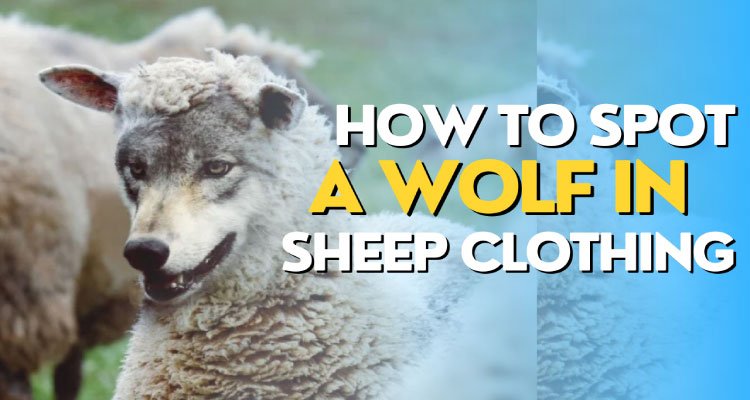Have you ever heard the saying, “A wolf in sheep’s clothing”? It’s not just a catchy phrase; it’s a metaphor that has stood the test of time. This expression paints a vivid picture of something or someone appearing harmless on the surface but concealing a hidden danger within. Just like a cunning wolf disguising itself in the woolly exterior of a sheep, deceptive individuals can blend in with the crowd, making it crucial for us to develop the ability to spot them.
In various life situations, this metaphor holds weight. It could be that seemingly friendly colleague who’s not as genuine as they appear or a sweet-talking salesperson trying to sell you something you don’t really need. Recognizing a wolf in sheep’s clothing is a valuable skill that can save us from potential harm or deceit. In this guide, we’ll explore five practical ways to identify these hidden threats.
Table of Contents
Toggle“A Wolf in Sheep’s Clothing” Origin
The origins of this phrase trace back through history, and interestingly, it has roots in various cultures. One notable source is the Bible, where in the Gospel of Matthew 7:15-23, Jesus warns his followers about false prophets who come disguised as sheep but are, in reality, wolves. This biblical metaphor emphasizes the importance of discernment and the ability to see beyond surface appearances.
Imagine a flock of sheep trusting a newcomer, only to discover that the supposed ally is, in fact, a threat. This cautionary tale highlights the timeless relevance of the concept. The idea of a wolf in sheep’s clothing has permeated cultural narratives, underscoring the need for vigilance and the ability to uncover hidden motives. In essence, this metaphor teaches us to question appearances and look beyond the woolly facade to discern the true nature of what or who we encounter. So, armed with this knowledge, let’s delve into practical ways to spot a wolf in sheep’s clothing.
Related: How to Protect Your Energy in a Hectic World
Characteristics of a Wolf in Sheep’s Clothing
Now that we understand the metaphor, let’s look at the characteristics that often accompany a wolf in sheep’s clothing. Recognizing these traits can be key to safeguarding ourselves from potential deceit.
- Charming Exterior, Hidden Agenda: A common trait is an outward charm that masks ulterior motives. Picture that colleague who always has a friendly smile but might be undermining your efforts behind your back.
- Master of Deception: Wolves in sheep’s clothing excel at concealing their true nature. They may present themselves as trustworthy and reliable, making it challenging to discern their real intentions until it’s too late.
- Manipulative Behavior: Deceptive individuals are adept at manipulation. They might use flattery, persuasion, or emotional tactics to achieve their goals. For instance, consider the salesperson who convinces you that their product is a must-have, even if it isn’t.
- Inconsistent Actions: Wolves in sheep’s clothing often exhibit inconsistency in their actions. Pay attention to behavior that doesn’t align with their words, as this can be a red flag.
- Lack of Genuine Empathy: While they may feign empathy, wolves in sheep’s clothing often lack genuine concern for others. Their actions may reveal a self-centered agenda rather than a sincere interest in the well-being of those around them.
Why It Matters to Spot A Wolf in Sheep’s Clothing
Recognizing a wolf in sheep’s clothing is more than an intellectual exercise—it’s a crucial skill with tangible consequences. Here’s why it’s essential:
- Guarding Against Betrayal: Identifying deceptive traits is your first defense against betrayal and backstabbing. Failing to recognize such individuals can lead to trust issues and compromised situations.
- Protecting Emotional Well-being: Deceptive individuals can manipulate emotions, causing emotional distress. Identifying a wolf early on is crucial for preserving your emotional health.
- Safeguarding Professional Reputation: Falling victim to deceit in the professional realm can harm your reputation and career. Recognizing signs of deceit helps you navigate workplace dynamics with discernment.
- Building Authentic Relationships: Wolves in sheep’s clothing undermine genuine connections. By avoiding them, you pave the way for more meaningful personal and professional relationships.
- Enhancing Decision-Making: Spotting deception is a valuable skill in decision-making, whether in hiring, forming partnerships, or making strategic choices. Knowing who you can trust allows for more informed and successful decisions.
Also see: Toxic Empathy and Setting Healthy Boundaries
5 Ways to Spot a Wolf in Sheep’s Clothing
1. Recognizing Deception
Notice Inconsistencies in Communication: Deceptive individuals may contradict themselves or provide conflicting information. For instance, someone claiming honesty but frequently embellishing stories or altering details could be a wolf in sheep’s clothing.
2. Behavioral Red Flags
Pay Attention to Non-Verbal Cues: Deceptive behavior often manifests in body language. Watch for signs like avoiding eye contact, nervous gestures, or defensive postures. These can be red flags indicating someone is not genuine.
3. Trust Your Instincts
Listen to Your Gut Feelings: Your intuition can be a powerful tool. If something feels off or inconsistent in a person’s behavior, trust your instincts. For instance, if you sense discomfort or unease around someone, it’s worth exploring further.
4. Patterns of Manipulation
Identify Consistent Manipulative Tactics: Deceptive individuals often employ manipulation tactics repeatedly. Look for patterns, such as guilt-tripping, gaslighting, or playing the victim. Recognizing these consistent behaviors helps uncover their true nature.
5. Social Media and Online Presence
Evaluate Digital Behavior: In the digital age, online activities can reveal a lot. A wolf in sheep’s clothing might maintain a facade in person but display deceitful traits online. Watch for discrepancies between their real-life and online personas, like inconsistent values or suspicious interactions.
Remember, staying vigilant and combining these methods can significantly enhance your ability to spot a wolf in sheep’s clothing in various aspects of life. Trust your observations and instincts, as they are valuable tools in navigating deception.
Concluding Thought on Spotting a Wolf in Sheep’s Clothing
In a world where deceit can lurk around any corner, staying vigilant is paramount. Recognizing a wolf in sheep’s clothing is not just a skill; it’s a shield against betrayal, emotional distress, and damaged relationships.
Remaining aware of inconsistencies in communication, non-verbal cues, and manipulative patterns empowers you to uncover deceptive individuals. Trust your gut instincts—they often reveal what words may conceal.
As you navigate both real-life interactions and the digital realm, evaluating online behavior becomes crucial. A wolf’s online presence may expose discrepancies that their offline persona conceals.
Your experiences and insights are valuable. Share them in the comments below to foster a community of awareness. Together, we can build a network of individuals equipped to identify and navigate the challenges posed by wolves in sheep’s clothing.
Stay vigilant, trust your instincts, and remember that knowledge is your best defense against those who would deceive.
Wolf in Sheep’s Clothing FAQ
Q1: What is a wolf in sheep’s clothing?
A wolf in sheep’s clothing is a metaphorical expression referring to someone who disguises their true nature or intentions with a harmless or benevolent facade. In essence, it describes an individual who appears gentle, trustworthy, or harmless but harbors deceitful motives or characteristics.
Q2: How to spot a wolf in sheep’s clothing?
To identify a wolf in sheep’s clothing, pay attention to key cues: Watch for inconsistencies in what they say, observe non-verbal signals like defensive body language, trust your gut instincts if something feels off, recognize patterns of manipulation such as guilt-tripping, and evaluate their online behavior for any disparities with their real-life persona.
Q3: What does the Bible say about wolves in sheep’s clothing?
The Bible, specifically in the New Testament, addresses the concept of wolves in sheep’s clothing. In Matthew 7:15 (New International Version), Jesus warns, “Watch out for false prophets. They come to you in sheep’s clothing, but inwardly they are ferocious wolves.” This verse cautions against false teachings and deceptive individuals who may appear righteous but have harmful intentions. It encourages believers to be discerning and cautious in their interactions with others.






